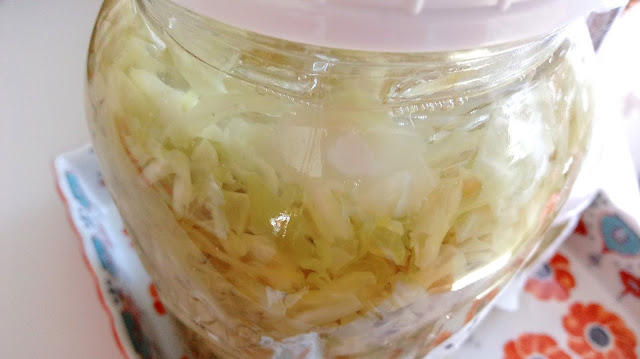 |
| Homemade Sauerkraut is one of our favorite condiments! |
Homemade sauerkraut is a simple process. It takes a little bit of elbow grease at the beginning and then a month's worth of patience to get the best result for both health and flavor.
Start by prepping your ingredients and equipment. This recipe makes half a gallon.

Slice or chop up a large head of green cabbage and grate a chunk of ginger.

Let the cabbage hang out on the counter while you mix up the brine.

Now you can pack the cabbage into a half gallon mason jar (or evenly into two quart size jars) and fill with brine leaving an inch of headspace.
 |
| When making Homemade Sauerkraut, make sure the cabbage is always immersed in the brine. |
Make sure the brine and cabbage are well mixed and then push the cabbage down into the brine.
Now it's time to seal the jar. You can use the whole anaerobic set up with a weight and air lock if you have it and like to work that way. You can also loosely place a regular jar lid over the jar so that gas can escape and unwanteds can't fall in. You'll just have to watch your kraut a little more closely.
Place in a cool, dark place with a rimmed dish underneath to catch any juices that may bubble up and over. We also stick on a label made of simple masking tape and mark the date we made the kraut to keep track of when it will be ready.
During the first week or so you're gonna want to check your kraut every day. If using a simple jar lid, you'll have to push the cabbage down into the brine using a clean spoon. After a week or two the ferment will stop bubbling up as much and the cabbage will stay down in the brine without help.
Wait at least 30 days for the best results. Then refrigerate and thoroughly enjoy.
 |
| This is what your Homemade Sauerkraut should look like mid-ferment. |
Here's what your kraut should look like mid-ferment. The cabbage will turn from green to more of a yellow color.
 |
| Here's what your fully fermented Homemade Sauerkraut should look like. |
Our favorite way to eat our homemade sauerkraut is with our Sheet Pan Brat, Potato & Onion Dinner (recipe coming soon). It's also the secret ingredient in our favorite tuna salad (click here for the recipe).
Homemade Sauerkraut
(recipe adapted from Fermented Food Lab)
INGREDIENTS
1 head green cabbage
1 Tbsp fresh grated ginger (optional)
2 Tbsp kosher salt, divided
4 cups purified water
1 Tbsp raw apple cider vinegar
DIRECTIONS
1. Slice or chop cabbage to the size you like your kraut. I like to slice longwise and then add 2 or 3 perpendicular chops.
2. Dump the cabbage, grated ginger, and 1 Tbsp of salt into a large bowl and massage for 5 minutes until the cabbage begins to break down. Leave on the counter for 15 minutes while you mix up the brine.
3. Heat 1 cup of the water until just hot and dissolve 1 Tbsp of salt into it. Then add the rest of the water and the Tbsp of raw apple cider vinegar. Mix well.
4. After the 15 minutes is up, pack the cabbage into the jar and add the brine leaving an inch of headspace. Mix well and then push the cabbage down below the brine.
5. Seal with weight and air lock lid, if using. Or loosely put on a regular jar lid. You wanna make sure gas can escape, but stuff can't float in.
6. Place jar in a rimmed dish that can catch any bubbling over juice and set in a cool, dark place. Check it daily for the first week or two. If using a regular jar lid you'll have to push the cabbage down into the brine with a clean spoon. Leave to ferment at least 30 days. Then refrigerate and enjoy.


No comments:
Post a Comment